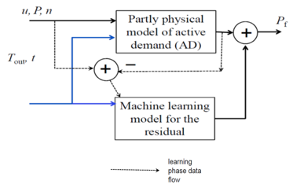EU-SysFlex blog: Electrically heated households to provide frequency reserves
23.03.2020NewsDetermining the potential of an aggregation of 727 houses can provide for manual Frequency Restoration Reserves in the Finnish market.
The consumption of electricity of 727 households in the Helsinki area is modelled and forecasted in order to identify their ability to provide services to the Finnish transmission system operator (TSO). In the current system, their heating pattern is optimized to consume electricity during the night, when the hourly prices are the lowest. In EU-SysFlex, the objective is to determine ways to actively control them in order to provide services and increase their value.
The reason those houses are so valuable for the system is that their heating system was designed with a high degree of flexibility. Each of them is equipped with a hot water tank dimensioned in such a way that, on most days, the charging can be done during the cheap hours of the night and the consumption of heat for heating of space and water over the whole day does not deplete the reservoirs. With the appropriate contracts, Helen, the electricity retailer, could modify the consumption patterns and use the infrastructure of Helen Electricity Network, the distribution system operator (DSO), to send signals to the heating systems.
Due to technical limits, the control of the heating systems is not possible using the current Automatic Meter Reading (AMR) devices. The communication with the meters and their reaction times are too slow to provide fast reacting frequency reserves. Manual Frequency Restoration Reserves (mFRR) in the Finnish market with an activation time of 15 minutes was demonstrated as possible, but only for a handful of houses at the same time. Instead of a full-fledged implementation, the project is simulating how the houses could be controlled with other communication technologies or with the next generation of smart meters, currently in the specifications phase.
The forecasting, optimization and simulation of the test cases is performed by VTT (Technical Research Centre of Finland) in collaboration with Helen and Helen Electricity network. The forecasting of the loads is performed based on a hybrid model for households. The hybrid model is created by using first a physically based model with temperature as an input which is then corrected with a neural network algorithm (a piece computer software designed to recognize patterns). The advantage of a hybrid approach is that neural networks are typically more accurate that physically based models, but they tend to give poor results in situations that haven’t been or have rarely been encountered during their training. Such a situation would correspond to extreme temperatures. A hybrid model uses the advantages of both approaches.

After running the simulations, the possible profit from operating a house on the mFRR market for a single hour per day is calculated to be between 40€ and 50€ per year. It should be, however, noted that this sum has to be shared between the actors involved (house owner, retailer and DSO/communication system provider). Moreover, the revenues are severely reduced by the increased distribution fees. For such an action to be profitable, it is suggested to change the way connection fees are determined for system service providers.
Written by: Corentin Evens (VTT Ltd.), In the EU-SysFlex project, VTT’s contribution is in developing tools for the demonstrator in Finland and to provide inputs regarding market structures, market simulations and to the building of road maps and recommendations.
VTT is an Research Technology Organization whose activities are focused on three areas: knowledge-intensive products and services, smart industry and energy systems, and solutions for natural resources and environment. VTT is impact-driven and takes advantage from its wide multi-technological knowledge base to strengthen Finnish and European industrial competitiveness. VTT can combine different technologies, produce information, upgrade technology knowledge, and create business intelligence and value added for its stakeholders.
For more information about EU-SysFlex, follow us on Twitter, Facebook and LinkedIn.
Disclaimer: blog entries reflect individual views of the author(s) that may not reflect official positions or communication of the project / project consortium.